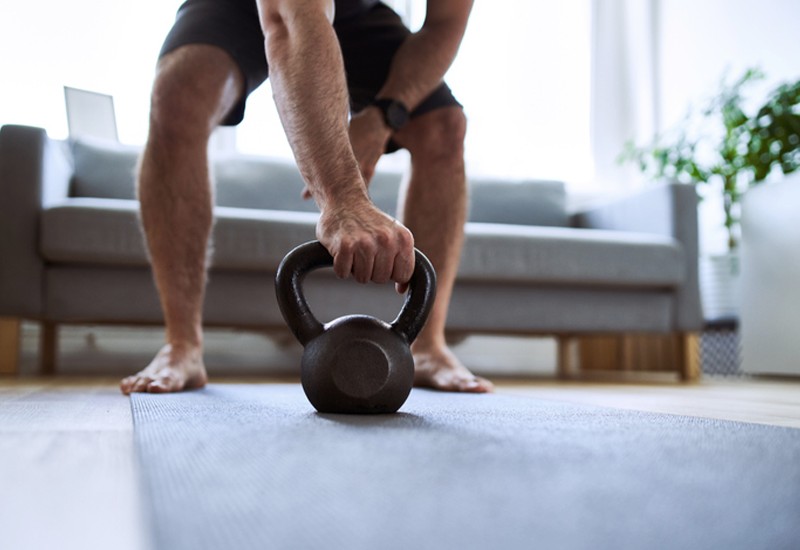
Barefoot Training: What You Need To Know
What’s The Story?
“In recent years, there has been a rise in popularity of barefoot training – including barefoot running – with the theory that humans were designed to move unshod. Advocates of barefoot training say it gives you an opportunity to reconnect with your body and work with your muscles, not against them. When it comes to running, it’s believed going shoeless encourages you to stop striking your heels on the floor, aiding both safety and speed, while lifting weights barefoot boosts neural feedback and ultimately increases power output. By taking away the artificial cushioning of a pair of trainers, you land more softly when running. Barefoot running also forces you to shorten your strike to avoid a heel strike, which increases your cadence. And when you lift weights barefoot, you engage more of the smaller, intrinsic muscles that provide you with a better grip, control and overall foot stability. There’s a real argument behind it.” – Christophe Champs, founder of Podo
Are There Some Sports That Training Barefoot Is Particularly Good For?
“Any sport where your feet are your tool – think gymnastics, yoga, barre and Pilates – can benefit from barefoot training. At the same time, activities where your feet are constantly changing direction – such as tennis, boxing and running – can also be improved by going shoeless. Your feet account for a quarter of your skeleton and are your only foundation in most sports. You’ll certainly miss out by not training such an important part of your body, especially in terms of their flexibility and mobility.” – Christophe
“Barefoot training strengthens the small muscles in your ankle joints better than shoe training, as the body senses change in the training surface and makes your sensory system more alert. These small muscles are also responsible for joint stability and can help make you more reactive when it comes to changing foot position and direction. Barefoot training can enhance any sport that involves speed, stability and control – think football and basketball.” – Emanuele Calabrese, osteopath MSK & pain expert at The Body Lab London
What About Lifting Weights?
“Your feet are covered in nerve endings, and when they are directly exposed to the ground, your brain not only gets more information, but it gets this information faster. When you lift in a cushioned pair of shoes, you’re essentially trying to lift a weight on an unstable surface, which isn’t conducive to very heavy lifting, such as a one-rep deadlift. If you want to lift more weight, you need a solid base, and going barefoot can help.” – Christophe
Tell Us About Barefoot Shoes...
“If you’re into fitness, you’ll probably have seen someone in your gym or local park wearing barefoot trainers, and these can be a good way to try it out. Various running shoe styles have been designed in recent years using the principle of the zero-drop or minimalist outsole, making for a barefoot-style gait. The one thing they all have in common is a flexible upper, flattened sole and little in the way of underfoot cushioning. They will protect your feet superficially but won’t do the hard work for you. When trying on a pair, the heel cup should ideally support your heel nicely to keep your fat pad – which is a better cushion than any shoe foam – well under your heel. When wearing them, always think about your stance and posture.” – Christophe
Any Tips For Getting Started?
“Before you even think about dipping your toe in – quite literally – it’s imperative to ensure your basics are right. Book in with a podiatrist or physio to get your alignment, balance and posture checked. Even the smallest muscular imbalance can cause an injury. Hypermobile people (around 25% of us – this means you are able to move some or all of your joints more than most people can) have a tendency to use their extrinsic muscles more when training barefoot – i.e. using their calves, tibial anterior, tibial posterior and long and short fibular muscles. Giving these muscles more work without reinforcing them first will put you at an increased risk of fatigue, pain and injuries. When everything works well, the foot will act like a wheel on a bike – it will stock and restore kinetic energy created by your movement.” – Christophe
“Be patient. Like any training change, barefoot training needs to be introduced slowly and gradually, otherwise you’re likely to suffer more injuries rather than less. Speak to any physio and they’ll have a story about treating a barefoot running enthusiast who embraced the change too quickly and ended up with a metatarsal fracture. Instead of throwing out your trainers, gradually incorporate barefoot sessions into your week. If you want to run barefoot, try walking first to get used to the sensation and then build yourself up, starting on a low mileage. You may notice changes in around three to six weeks. Finally, don’t feel like you have to embrace barefoot training all the time. Doing one barefoot session a week can add variability to your routine and it can be become a useful way to enhance performance and keep the body challenged.” – Katie Knapton, CEO & founder of Physio Fast Online
For more, head to TheBodyLabLondon.com, Podo.London & PhysioFastOnline.co.uk
DISCLAIMER: Features published by SLMan are not intended to treat, diagnose, cure or prevent any disease. Always seek the advice of your GP or another qualified healthcare provider for any questions you have regarding a medical condition, and before undertaking any diet, exercise or other health-related programme.
DISCLAIMER: We endeavour to always credit the correct original source of every image we use. If you think a credit may be incorrect, please contact us at [email protected].

